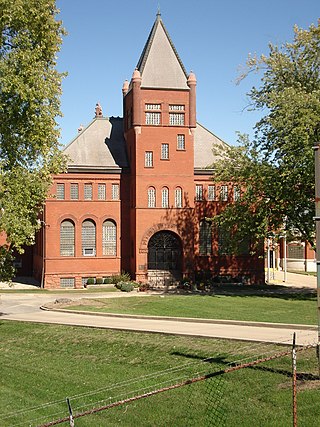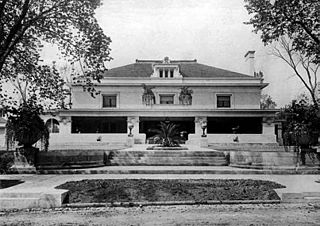
The Ruben M. Benjamin House is a house in Bloomington, Illinois. It is a two-story rectangular building, styled in the Classical Revival architectural motif. It was built in 1856 John L. Routt, who would become the first governor of Colorado. Ruben M. Benjamin, an attorney known for litigation relating to railroad regulation, lived in the home for more than 60 years. The United States National Register of Historic Places added the Ruben M. Benjamin House in August 1978.

The Jacobs Block, also known as the National Clothing House, is an 1870s historic building encompassing addresses in the 400 Block of Washington Street and the 100 Block of North Fourth Street in Oregon, Illinois. The Jacobs Block is part of Ogle County's only nationally designated historic district. The area, known as the Oregon Commercial Historic District, was added to the National Register of Historic Places in August 2006. The building, listed as a contributing structure to the historic district, is the Oregon Historic District's largest.

Round Barns in Illinois was the subject of a Multiple Property Submission to the National Register of Historic Places in the U.S. state of Illinois. The submission consists of 18 Illinois round barns located throughout the state. The list had major additions in 1982 and 1984. In 1983, 1992 and 2003 one property was added to the submission and in 1994 a historic district at the University of Illinois, including three round barns, was added to the submission and the National Register of Historic Places. The highest concentration of round barns on the submission occurs in Stephenson County. Five Stephenson County round barns were added to the National Register on February 23, 1984.

The University of Illinois Experimental Dairy Farm Historic District, also known as South Farm, is a designated historic district in the U.S. state of Illinois. It is located on the campus of the University of Illinois in Urbana, Illinois. The district consists of eight contributing structures and several non-contributing structures. The district was designated in 1994 when it was added to the National Register of Historic Places as part of the Multiple Property Submission concerning Round Barns in Illinois. Three of the district's buildings are early 20th century round barns constructed between 1908 and 1912. The district covers a total area of 6 acres (2 ha).

The Cumberland Presbyterian Church, also known as the Peoria Musicians Club or Musicians Hall, is the oldest standing church building in Peoria, Illinois, United States. The church was constructed in 1856 as the First Cumberland Presbyterian Church. It was used by various churches and a synagogue until 1913, when it was bought by the American Federation of Musicians Local 26. The building was added to the National Register of Historic Places on March 18, 1980. The building is also a City of Peoria Historic Landmark as of March 1996. It is now a branch of Busey Bank.

The John C. Proctor Recreation Center was constructed in Peoria, Illinois, United States in 1913. The Classical Revival center was built per the provisions of its founders will, John C. Proctor. It was designed by Hewitt & Emerson. The building was added to the National Register of Historic Places on September 6, 1979.

The Judge John C. Flanagan Residence is a historic house in Peoria, Illinois, United States. It was added to the National Register of Historic Places in 1975 and is currently operated as a museum by the Peoria Historical Society.

The North Side Historic District is a Registered Historic District in Peoria, Illinois, United States. The district is located on a terrace at the bank of the Illinois River and is predominantly residential. The district was added to the National Register of Historic Places on November 21, 1983. Due to the growth of the city in the 20th century, this original North Side is now in the southeastern quadrant of the city.

Peace and Harvest are two 8-foot (2.4 m) tall limestone statues in downtown Peoria, Illinois, United States. The male and female figures represent peace and harvest respectively. The statues were sculpted by Chicagoan Mary Andersen Clark as part of the Works Progress Administration's Federal Art Project, and were added to the National Register of Historic Places in 1988.

Peoria Mineral Springs is 14,500-year-old natural spring in the city of Peoria, Illinois, United States. The site, also known as Spring Hill, is located on a hillside on the historic West Bluff between Martin Luther King Jr. Drive and Moss Avenue.

Peoria Waterworks is a building complex built in 1890 for the Peoria, Illinois water system.

The Pettengill–Morron House, or simply Morron House, is a historic mansion located in the city of Peoria, Illinois, United States. This Second Empire style home is located in the local historic Moss-High District. The property was added to the National Register of Historic Places and is a City of Peoria Local Historic Landmark. It currently operates as a museum by the Peoria Historical Society.

The International Harvester Building is a five-story building in the U.S. city of Peoria, Illinois. The property consists of the 1914 five-story building and a 1925 one-story addition. The building is associated with Peoria's history through transportation; Peoria was once a major shipping point due to its vicinity to the Illinois River and major railroad connections. The structure was added to the National Register of Historic Places on November 15, 2005, after the National Register's 50 year cut off for inclusion had expired on the building's original period of significance (1914-1955).

The Rock Island Depot and Freight House is a two-story railroad station and adjacent one-story freight house from the turn of the 20th century. It was constructed in 1899 directly besides the Illinois River in the American city of Peoria, Illinois. The depot and freight house are one of Peoria's last remaining historic reminders of the importance of passenger trains in the city's past, the other being the newer (1967) Rock Island station at 121 Morton Street now owned by the City of Peoria. The depot was built by the Chicago, Rock Island and Pacific Railroad as the terminus of a major branch line that delivered significant goods and passengers to Peoria. The 1900 opening of the depot was attended by "throngs of populous;" at its height before the depression of the 1880s, Peoria was a transportation hub. The station's clock tower was removed in 1939. The buildings were listed on the U.S. National Register of Historic Places in 1978. The last Rock Island train out of the station was the Peoria Rocket in 1978, of the company's Rock Island Rockets series.

Springdale Cemetery is a historic, non-sectarian, active cemetery in the United States city of Peoria, Illinois. It was chartered in 1855, received its first interment in 1857. Almost 78,000 individuals are buried at the cemetery. It contains a public mausoleum and 15 private mausoleums.

The West Bluff Historic District is one of three Registered Historic Districts in the Peoria County, Illinois, city of Peoria. The district is mostly residential and is an example of the opulence once enjoyed by the upper class in the United States during the late 19th and early 20th centuries. Of particular note are two contributing structures designed by Frank Lloyd Wright: Francis W. Little House at 1505 W. Moss Ave., and the house at 1316 W. Moss Ave. Other NRHP properties also listed as contributing to this district include the Judge Jacob Gale House at 1007 N. North St. and Pettingill-Morron House at 1212 W. Moss Ave. The district was added to the National Register of Historic Places on December 17, 1976.

The Frank Lloyd Wright/Prairie School of Architecture Historic District is a residential neighborhood in the Cook County, Illinois village of Oak Park, United States. The Frank Lloyd Wright Historic District is both a federally designated historic district listed on the U.S. National Register of Historic Places and a local historic district within the village of Oak Park. The districts have differing boundaries and contributing properties, over 20 of which were designed by Frank Lloyd Wright, widely regarded as the greatest American architect.

As of 2007 there are five church buildings in the Sycamore Historic District, located in Sycamore, Illinois, United States which are listed as contributing properties to the district. The Sycamore Historic District was added to the U.S. National Register of Historic Places on May 2, 1978. When it was nominated to join the National Register there were seven church buildings within the district. One of those included is a residential structure that was utilized as a church when it was first constructed; the Arthur Stark House was once home to the Sycamore Universalist Church congregation. In the time since its listing, two churches have been destroyed or demolished. The Evangelical Lutheran Church of St. John was destroyed by fire in 2004 and the United Methodist Church in Sycamore is no longer extant, replaced by a modern office building.

The Laura Gale House, also known as the Mrs. Thomas H. Gale House, is a home in the Chicago suburb of Oak Park, Illinois, United States. The house was designed by master architect Frank Lloyd Wright and built in 1909. It is located within the boundaries of the Frank Lloyd Wright-Prairie School of Architecture Historic District and has been listed on the U.S. National Register of Historic Places since March 5, 1970.

Pleasant Home, also known as the John Farson House, is a historic home located in the Chicago suburb of Oak Park, Illinois, United States. The large, Prairie style mansion was designed by architect George Washington Maher and completed in 1897. The house was added to the U.S. National Register of Historic Places on June 19, 1972. Exactly 24 years later, in 1996, it was declared a National Historic Landmark by the United States Department of the Interior.






















